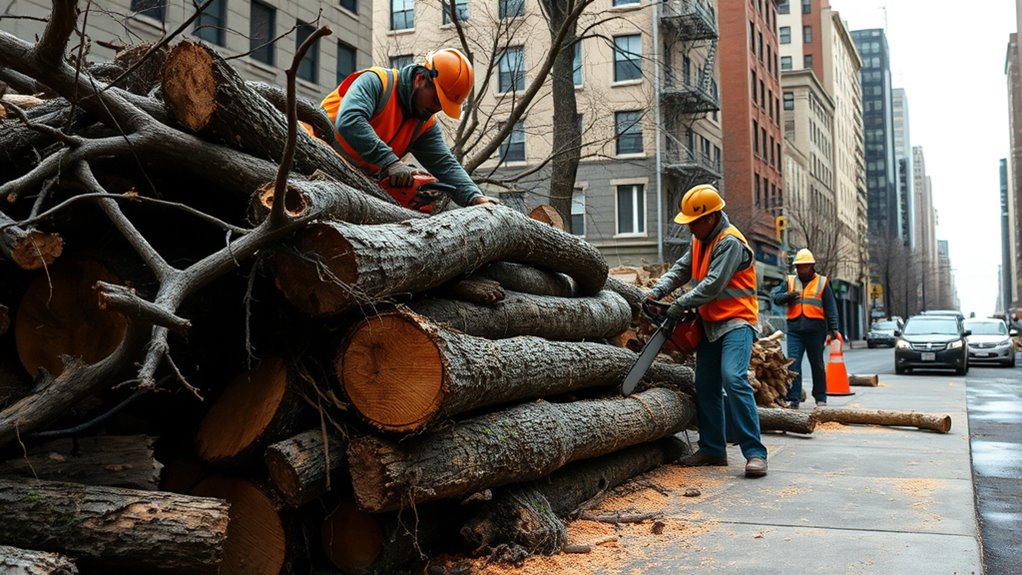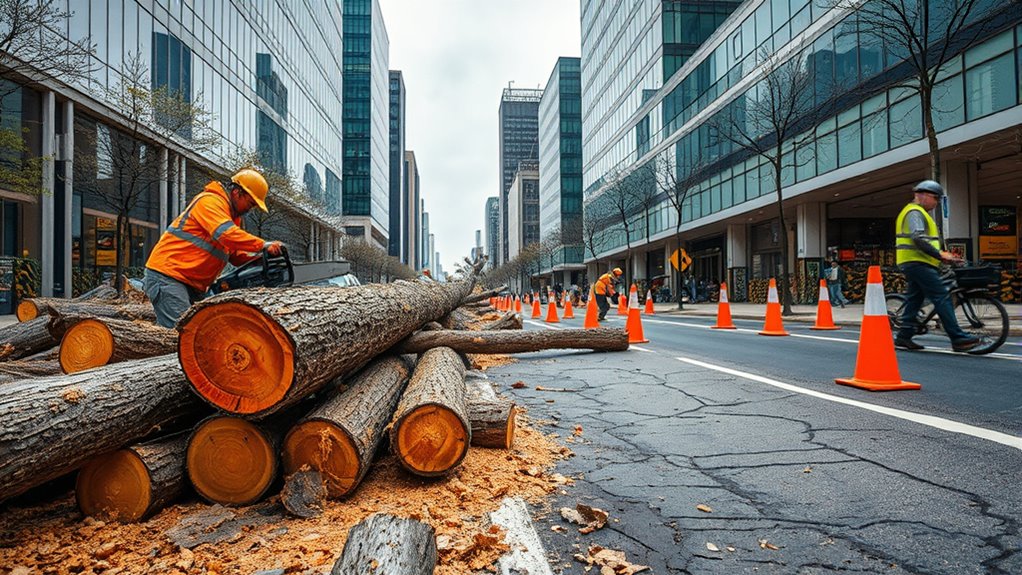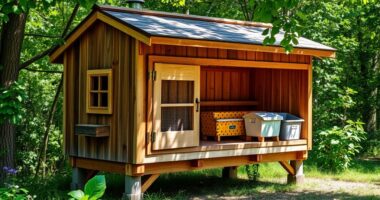Urban logging involves turning storm-felled trees into a valuable resource by harvesting free lumber for community projects and sustainable use. After storms, city crews safely assess fallen trees for rot, pests, and structural issues before selectively harvesting high-quality wood. This practice reduces waste, eases landfill burden, and promotes eco-friendly reuse. If you’re curious about how communities are transforming storm damage into practical resources, there’s more to discover about this innovative approach.
Key Takeaways
- Storm-felled trees can be safely harvested and repurposed into free lumber through urban logging practices.
- Proper assessment ensures storm-damaged logs are free of rot, pests, and structural issues before processing.
- Urban logging reduces landfill waste by transforming storm debris into valuable building materials.
- Community volunteers and skilled workers can participate in sustainable storm damage cleanup and lumber harvesting.
- Utilizing storm-felled trees for lumber promotes eco-friendly resource reuse and supports local sustainability initiatives.

Have you ever wondered how cities manage their trees and fallen logs? It’s a question that often goes unnoticed until a storm hits, leaving behind a trail of storm damage that calls for immediate action. When strong winds or heavy snow cause trees to topple, city crews spring into action to handle tree removal. Instead of just hauling away these fallen giants, some municipalities are finding ways to make the most of them. Urban logging has become a clever way to transform storm-felled trees into valuable resources, saving money and reducing waste.
After a storm causes damage, the focus is usually on clearing the debris quickly to keep streets safe and accessible. However, this process often results in large logs being discarded or chipped. What many city officials are realizing is that these logs can serve a new purpose—harvesting them for free lumber. When crews remove storm-damaged trees, they’re often dealing with more than just cleanup; they’re handling potentially high-quality wood that, if left untouched, would go to waste. Instead of paying for commercial logging or disposal, cities are turning to urban logging initiatives, which involve selectively harvesting fallen or dead trees for reuse.
This approach not only helps manage storm damage efficiently but also promotes sustainability. Urban trees, especially those that have fallen after a storm, can be repurposed into furniture, flooring, or firewood. The key is proper assessment and safety. You need to guarantee the logs are free from rot, pests, or structural weakness before processing them. Skilled workers or volunteers often handle this task, cutting and stacking the wood for future use. It’s a practical way to recycle what would otherwise be considered debris, turning storm damage into an opportunity for community projects or local crafts.
Another benefit is that urban logging reduces the burden on landfills and municipal waste systems. Instead of hauling away large logs for disposal, cities can create a local supply of free lumber that benefits schools, community centers, or residents. It’s a win-win situation, making storm damage work for the city rather than against it. Plus, this process fosters community engagement, as volunteers often join in the effort, learning about forestry and sustainability firsthand.
In essence, urban logging transforms the aftermath of storm damage from a problem into a solution. It’s a smart, eco-friendly way to handle tree removal, giving fallen trees a second life while saving resources. Additionally, by utilizing certified sources, cities can ensure that the wood they harvest is responsibly obtained and safe for reuse. As more cities explore this approach, they’re proving that even in the wake of chaos, there’s an opportunity to build something useful and lasting from the remains of storm-felled trees.
Frequently Asked Questions
What Permits Are Required for Urban Tree Harvesting?
When you plan to harvest storm-felled trees, you need to verify local regulations first. Urban forestry policies often require permits to ensure tree preservation and sustainable practices. You should contact your city or county’s forestry department or planning office to find out about specific permit requirements. This process helps protect urban trees and ensures your harvesting aligns with community standards and environmental guidelines, making your project legal and eco-friendly.
How Do I Ensure Safety During Urban Logging?
You might think safety is just about equipment, but evaluating tree health and conducting a thorough risk assessment are vital first steps. Investigate if the tree’s structure is compromised or diseased, as these factors increase danger. Always wear proper gear, keep a safe distance from unstable branches, and have a plan for emergencies. By understanding potential risks, you guarantee a safer logging process and protect yourself from avoidable accidents.
What Tools Are Best for Storm-Felled Trees?
When choosing tools for storm-felled trees, focus on tree identification to determine the best approach, and prioritize tool safety. Use a chainsaw with safety features, sharp blades, and proper protective gear. A handsaw or bow saw can work for smaller branches. Always inspect your tools before use, follow safety guidelines, and stay aware of your surroundings. Proper tool selection and safety precautions help you work efficiently and avoid accidents.
How Do I Identify Suitable Trees for Lumber?
When identifying suitable trees for lumber, look for healthy trees with straight trunks, minimal signs of disease or pests, and good wood quality. Check for dead or broken branches, fungal growth, or discoloration, which indicate poor health. Choose trees that are free from cracks, rot, or decay, ensuring the wood is strong and durable. Prioritize trees that meet these criteria to get the best quality lumber from storm-felled trees.
Are There Environmental Regulations for Urban Logging?
You should check local urban forestry regulations, as they often set rules to protect tree health and maintain city ecosystems. These laws help ensure that logging doesn’t harm the environment or compromise urban tree populations. By staying informed about your city’s policies, you can responsibly harvest storm-felled trees, supporting sustainable practices while preserving urban forestry. Always verify regulations before proceeding to avoid legal issues and safeguard your community’s green spaces.
Conclusion
Urban logging offers a sustainable way to turn storm-felled trees into free lumber, reducing waste and supporting local economies. Did you know that cities can save thousands of dollars annually by harvesting these trees instead of removing and disposing of them? By embracing urban logging, you help cut down on waste, lessen environmental impact, and make the most of what nature provides. It’s a simple, effective way to turn a storm’s mess into valuable resources.









